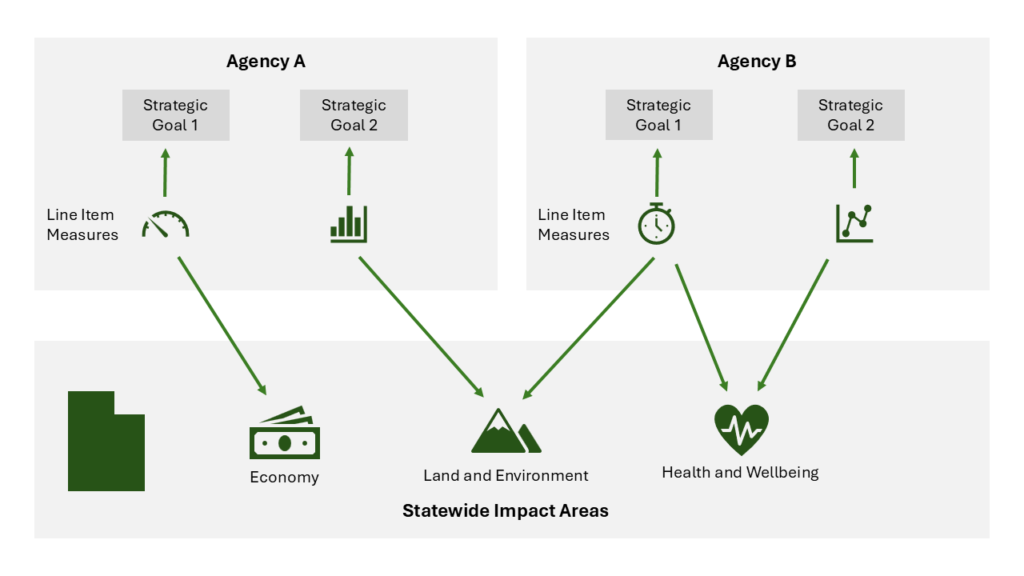Passed on the 10th day of session, the base budget bills for state agencies provide important direction for state agencies in the upcoming budget year. Included for Fiscal Year (FY) 2026 is intent language establishing line item performance measures for most line items of every agency. This post will serve as a refresher on what performance measures are, how they’re used, and things the Legislative Fiscal Analyst and Governor’s Office are actively working on to improve their’ usefulness and relevance. To keep things interesting, we’ll use parts of J.R.R. Tolkien’s classic series, The Lord of the Rings, to illustrate how performance measures might work in the real (or fantasy) world.
Line Item Performance Measures Tell an Agency’s Story over Time
Performance measures help tell the story of the progress agencies are making in their efforts to transform appropriated funds into real-world impacts for Utahns. Measures can take a variety of formats, including a count (such as the number of people served), a percentage (such as the proportion of tasks completed on time) or a dollar amount (such as cost savings achieved). On Frodo’s quest to save Middle Earth, some of his performance measures might have included the number of miles traveled toward Mordor, the percentage of orcs defeated in battle, or the time needed to send a call for help to their allies in Rohan. And, whenever possible, performance measures should be designed to reflect the actual outcomes of a funded activity, rather than just the output—were the people of Middle Earth successful in defeating evil? Or in the real world, are Utahns better off than before because of any given state-funded activity?
This year’s nine base budget bills contained 738 unique measures that agencies will report on, which are associated with 209 line items in the state’s budget structure. While most of these line items have between one and four measures, some of the largest line items representing vast operations have significantly more—Public Education’s Basic School Program (22 measures), Utah Department of Transportation’s Support Services (14 measures), and Department of Workforce Services’ Operations and Policy (10 measures) to name a few.
Some examples in this year’s base budget bills include:
- Measure of Recidivism (Board of Pardons and Parole)
- Per Capita Rate of Statewide Air Emissions (Department of Environmental Quality)
- Transit Ridership (Department of Transportation)
- Persons Returning to Homelessness (Department of Workforce Services)
Each of these measures help legislators make ongoing decisions about how to prioritize, increase, decrease, or reallocate funding throughout the state budget based on each line item’s performance.
Connecting the Dots—Making Measures Meaningful
The story of The Lord of the Rings centers around a single artifact—one ring to rule them all! Unfortunately, in our budgetary quest to improve state government operations that serve Utah’s residents, there is no single performance measure to rule them all (but we’ll keep an eye out in case we find one). Therefore, a suite of complimentary measures is often necessary to connect the dots, understand whether programs are operating effectively, and see beyond the expenditures to assess larger-scale progress toward agency or statewide initiatives.
A previous post on this topic, “Metrics that Matter,” discussed the importance of linking performance measures to agencies’ strategic plans to show policymakers whether they are effectively using appropriated funds to fulfill their agency-wide missions. Building on this concept, the LFA Ops. Team plans to introduce new features that will connect measures to broader statewide initiatives and policy areas, such as housing, energy, public health, or transportation. Beginning in 2025, agencies will be required not only to directly connect each measure to part of their strategic mission statement, but also to connect each measure to relevant statewide policy impact areas.
For example, let’s sat a constituent is interested in understanding all of the funding across the state that is related to environmental issues As illustrated in the graphic below, ‘Agency A’ and ‘Agency B’ may both have measures that relate to their agency-level goals, and also to the broader “land and environment” area. With the new impact area tags, a user will be able to filter for “land and environment” and see a comprehensive list of related funding and performance measures from Agency A, Agency B, and any other parts of the state that are working on this issue. Legislators may recognize these categories as the “subjects” required as part of the Request for Appropriations process.

Just as Frodo, Gandalf, and Aragorn in The Lord of the Rings each had to complete their own individual quests to defeat Sauron and save Middle Earth, each program, line item, and state agency has its own role to play in achieving the state government’s broader missions. The goal of connecting topical performance measures with spending data is to equips policymakers with the type of information required to make budgeting decisions that move the state toward key objectives.